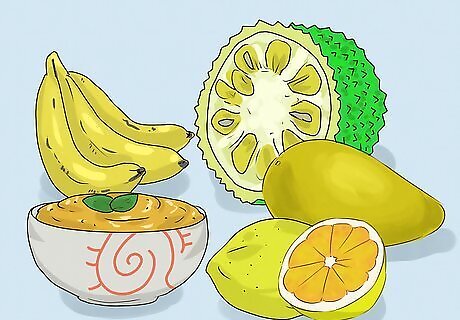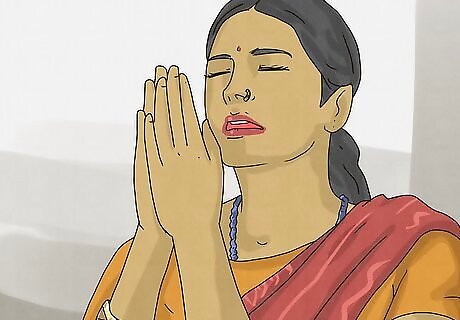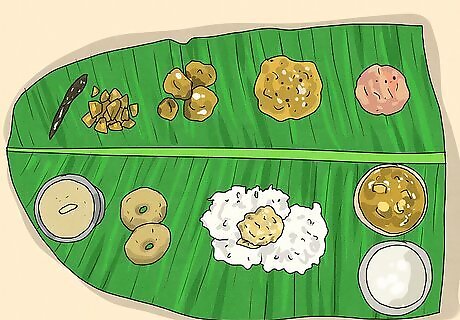
views
Making Preparations the Day Before Puthandu

Clean your home on the eve of Puthandu. Part of what is celebrated during the Tamil New Year is the possibility of new beginnings during the next year. As part of this celebration of new beginnings, start your festivities by cleaning and tidying your home in preparation for the new year.The entrances to the houses are decorated elaborately with kolams (design made with rice flower) and adorn the doorway with mango leaves. Some people choose to perform this housecleaning on Puthandu instead of the day before. Either practice is acceptable, though you will probably have more time for feasting and worshipping during the first day of the new year if you clean your home the day before.

Gather foods of the six different tastes. Food preparation will happen the day of Puthandu, but you should gather the food you'll prepare ahead of time. Follow the principle of arusuvai, the six different tastes found in Tamil cuisine: sweet, salty, bitter, sour, spicy (also known as "kaaram") and a taste called "thuvarpu." "Thuvarpu" is the taste of a common post-meal nut called the betel nut. It is also the taste of Indian gooseberry. In addition, you can also start preparing for festival dishes, such as vadai, payasam, etc. "Pacchadi," or a yoghurt based dish generally prepared with mango, is a must. Also choose mukkani, three fruits—mango, jackfruit, and banana—that are considered to be the tastiest fruits. They are also common items included in the meals for "putthaandu."

Decorate the entrance to your house with kolams. Use rice flour or chalk to draw kolam designs around the main entryway of your home. Place a kuthu vilakku lamp at the center of the kolam to dispel darkness and make your kolam more festive. You should use colorful rice flour or chalk for drawing the kolams. Any and all colors can be used for the kolams.
Celebrating on the First Day of the New Year

Take a cleansing bath on the day of. Be sure to cleanse yourself from head to toe. The bath is an integral part of the celebration of new beginnings in the new year. Many people choose to take herbal baths on this day, although a normal bath will also suffice. Turmeric baths, commonly for women, can be extended to all on this day.

Get new clothes for the festival (optional). While not a mandatory practice, some families choose to get new clothes for the festival. Like the cleansing bath, wearing newly bought items of clothing is another way of celebrating the new beginnings that the new year portends. Go shopping for new clothes in the days leading up to the new year and wear them for the first time during Puthandu. Some people opt to wear their best traditional clothes during Puthandu instead of brand new clothes. However, most people will tell you that tradition dictates wearing new clothes on this day.

Give offerings and prayers to the gods. As part of your morning routine on the first day of the new year, you should begin praying and giving offerings to your idols after your cleansing bath. Offerings can include fruits and sweets as well as decorations for the idols, such as garlands. Families come together to complete prayers together, and this time of prayer includes aspects of fire: lamps, "aarathi," lighting "saambrani," and incense sticks. Prayer may also include divine sounds: chanting specific phrases, ringing brass bells at home, singing divine songs, playing classical instruments, etc. In Sri Lanka and parts of India, pongal (an Indian rice dish) is commonly offered to the gods during Puthandu.

Visit friends and go to a temple to seek blessings. After bathing and giving offerings and prayers to your idols, head over to a local temple to pray and seek blessings to ensure your new year is full of growth and prosperity. Take this time to visit friends and family as well in celebration of the new year. When visiting the temple, it is also common to break coconuts in designated areas. Coconuts have important significance in Hinduism. Often, these are offered to Lord Ganesha and broken, symbolizing the removal of obstacles and having a smooth life forward. Breaking a coconut on new year's symbolizes ones prayers for a year without obstacles and challenges. Brahman Bhoj is also performed on this auspicious occasion. To seek the blessings of the lord, people visit temples where the head priest usually reads out the “Panchangam.” During visits with friends and families, bring small delicacies and sweets to be exchanged. Sometimes only children are expected to exchange foods and sweets, but many adults also take part in this Puthandu tradition.

Have an elder member of your family read from the Panchangam. A Panchangam is a Hindu calendar and almanac, organized by traditional Hindu timekeeping and which presents important dates and calculations for the upcoming year. As part of your Puthandu celebrations, have your members of your family sit together while the most elderly member reads from the almanac.

Partake in a vegetarian feast. The final element of celebrating Tamil new year is holding a large feast among friends and family. The main dish of this feast is Mangai-pachadi, which incorporates a variety of flavors to signify the different periods in life. The feast should only be comprised of vegetarian dishes on Puthandu. Examples of dishes you could add to your feast include sweet dhal poli and veppam poo rasam.

















Comments
0 comment